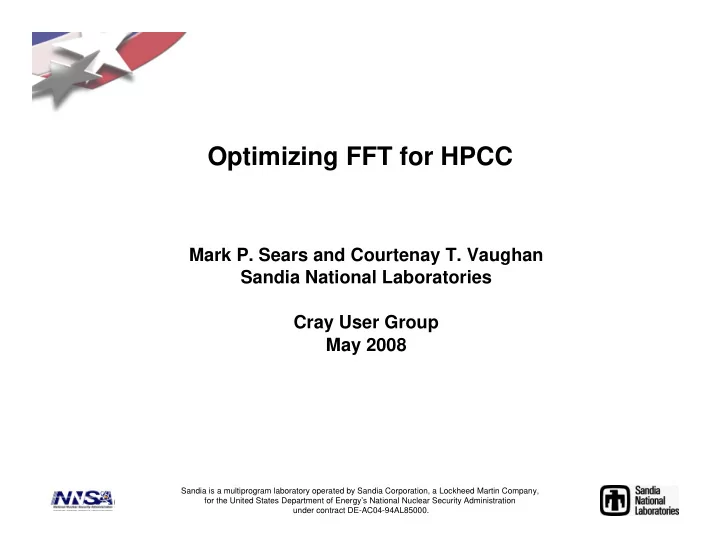

Optimizing FFT for HPCC Mark P. Sears and Courtenay T. Vaughan Sandia National Laboratories Cray User Group May 2008 Sandia is a multiprogram laboratory operated by Sandia Corporation, a Lockheed Martin Company, for the United States Department of Energy’s National Nuclear Security Administration under contract DE-AC04-94AL85000.
HPCC • Series of 7 benchmarks in one package. They include: – PTRANS - matrix transposition – HPL - Linpack direct dense system solve – STREAMS - Memory bandwidth – Random Access - Global random memory access – FFT - large 1-D Fast Fourier Transform • Code is C with libraries
HPCC • Meant to give a better indication of machine performance than just using HPL as a ranking – Different tests stress different aspects of machine performance • Annual competition at SuperComputing – Allows optimization of tests
FFT in HPCC • 1-D FFT of a large complex double precision vector • Requires all-to-all communication • Stresses interprocessor communication of large messages • Algorithm must use given size and validate using existing inverse transform • HPCC version 1.0 used a power of 2 number of processors • HPCC version 1.2 expands that to the largest number of processors that can be factored by 2, 3, and 5
FFT Theory • Discrete Fourier Transform (DFT) of a vector of length N • If N can be factored so N = nm then the DFT can be written as: – n DFT operations of length m – twiddle operations (multiplying by appropriate complex roots of -1) – m DFT operations of length n • These operations are applied recursively until the length is small and then the DFT is explicit
Parallel FFT • Serial DFT factorization introduces a shuffling of the order of the array • In serial this is handled by reordering the vector • Requires transpose among processors for the parallel case
FFT Algorithm • Vector decomposed as N = P*M*P where P is the number of processors 1. Parallel block transpose 2. Local FFTs on z with twiddle 3. Parallel block transpose 4. Local FFTs on y with twiddle 5. Local FFTs on x 6. Parallel transpose
Cache • End up with doing small FFTs over vector entries that are not contiguous – length of small FFTs is 2, 3, 4, 5, 8 – numerically intensive portion of code • Do pack and unpack operations – Allows reuse of cache lines • Baseline algorithm not tuned for Red Storm
Parallel Transpose • Baseline algorithm uses MPI_AlltoAll – Not optimized for Red Storm • We use pairwise exchange of messages – Each processor exchanges a message with one other processor in turn (pairwise) – Exchanges are ordered so that all processors are busy at all times – Significant improvement in scalability (much smaller buffers, reduces message overhead) – Allows overlap of packing with communications
FFT Results from Red Storm • HPCC version 1.0 on 25920 cores – Baseline 1554 GFLOPS – Optimized 2871 GFLOPS (#1 at SC 07) – FFT used 16384 cores (mix of 1 core per node and 2 cores per node) • HPCC version 1.2 on 16384 cores on 8192 nodes – baseline 1234 GFLOPS – optimized 2272 GFLOPS • HPCC version 1.2 on 25920 cores – baseline 2755 GFLOPS – optimized ?
Summary • Tuned algorithm ~2X over baseline • Fastest FFT on any computer
Recommend
More recommend